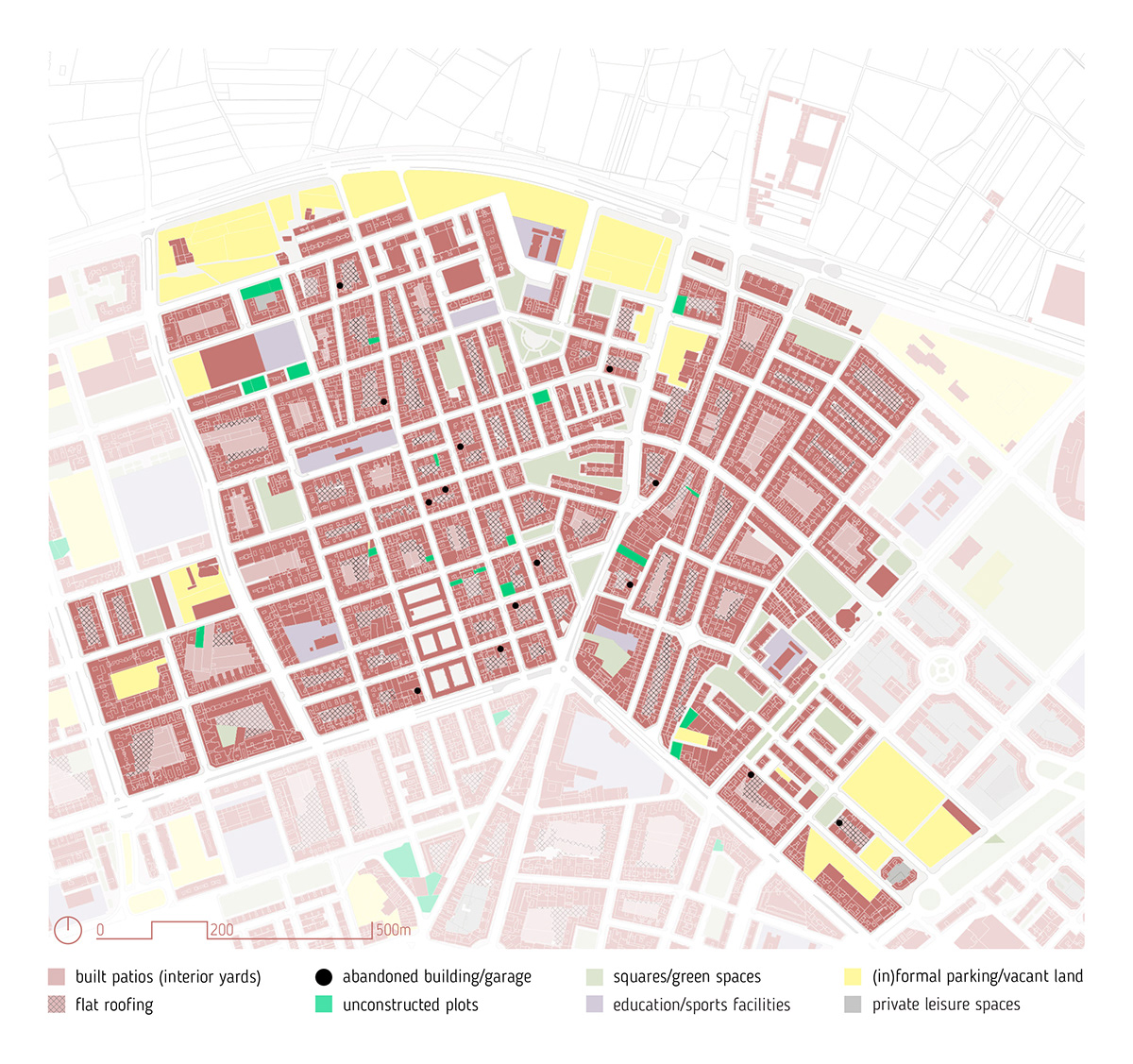REGENERATING PATIOS | SUSTAINABLE INTERVENTIONS FOR URBAN REGENERATION
This urban planning project centres around Torrefiel and Els Orriols, two peri-urban neighbourhoods of Valencia that grew extensively in the 60s-70s, during a period of extensive urbanisation combined with rapidly constructed mass-housing. This district is closely linked to the ‘huerta’, a historically agricultural region which at the moment is strongly urbanised and industrialised. The objective of the intervention is the gradual regeneration of the neighbourhoods, with a special focus on environmental and socioeconomic sustainability.

ANALYSIS OF ROAD NETWORK AND PUBLIC TRANSPORT | 1:10.000
The current road network is organised in a relatively orthocanonical and hierarchical grid, while the area is adequately covered by the public transport network of buses, trams, as well as municipal bicycles.

VARIATION OF TEMPERATURE DURING SUMMER MONTHS

AIR (LEFT) AND NOISE (RIGHT) POLLUTION
The site specific urban microclimate is characterised by regular high temperatures and high concentration of air and noise pollution.

SOCIOECONOMIC DEMOGRAFIC DATA

URBAN MORPHOLOGY
When it comes to the socio-spacial landscape the area is inhabited by a socially underprivileged population, whereas the urban morphology corresponds to the typical Spanish building block with facades varying from historicism to post-war modernism.

ANALYSIS OF INTERIOR YARDS AND OPEN-AIR URBAN SPACE | 1:10.000
The interior yards of these blocks (patios in Spanish) are mostly covered by one-storey buildings with flat or inclined roofs, while the rest of the open-air urban spaces of the mainly residential area consist of (in)formal parking, vacant land, several green spaces, squares and education/sports facilities.

Through a SWOT analysis, a regeneration strategy is created, so that gentrification is hindered, social cohesion is encouraged and the microclimate is improved.

Among the strategic goals, central stage takes the rehabilitation and gradual integration of the patios and undeveloped open-air spaces in a network of (semi)public cores of socialisation.

NETWORK OF GREEN SPACES AND PUBLIC AMENITIES | 1:10.000
These new nuclei of activity are linked through networks of green pedestrianised streets which connect them with the different existing or introduced public amenities, thus contributing to the creation of Superblocks.

PEDESTRIANISATION AND PUBLIC TRANSPORT (LEFT) &
PATIO REHABILITATION AND NEW LAND USES (RIGHT)
A system of integrated sustainable public mobility is proposed through pedestrianisation, the increase of municipal bike stops and the extension of the tram network. The interventions to be further developed through participatory methods are to be applied gradually by firstly intervening in the aspects that are most urgent, cost-efective and with immediate results.

1st phase: 'open' block with flat roofed patio
and entrance though plot

2nd phase: 'closed' block with flat roofed patio
and entrace through building
The introduction of elevators, ramps or new staircases in the patios improves the accessibility of the buildings, while planted walls contribute to a better heat/sound insulation and air quality.


On the street level, the primary circulation axes are enhanced with urban greenery while the new pedestrian roads are appropriated by the local community.
BETRAN Marta | SANCHIS Lucas | RAIKIDOU Evangelia
2018 | ETSA UPV | Valencia, Spain
2018 | ETSA UPV | Valencia, Spain









